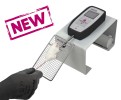Authors
J. J. Luszczki, K. M. Sawicka, J. Kozinska, M. Dudra-Jastrzebska, S. J. Czuczwar.
Lab
Medical University, Department of Pathophysiology, and Institute of Agricultural Medicine, Department of Physiopathology, Lublin, Poland.
Journal
Journal of Neural Transmission
Abstract
Accumulating evidence indicates that amiloride (a potassium-sparing diuretic) exerts the anticonvulsant action in various in vivo and in vitro experiments. Therefore, the objective of this study was to assess the influence of amiloride on the protective action of numerous conventional and second-generation antiepileptic drugs [AEDs: carbamazepine (CBZ), lamotrigine (LTG), oxcarbazepine (OXC), phenobarbital (PB), topiramate (TPM), and valproate (VPA)] against maximal electroshock (MES)-induced seizures in mice. Results indicate that amiloride [up to 100 mg/kg, intraperitoneally (i.p.), at 30, 60, and 120 min before the test] neither altered the threshold for electroconvulsions, nor protected the animals against MES-induced seizures in mice. Moreover, amiloride (75 and 100 mg/kg, i.p., 120 min prior to the test) significantly enhanced the anticonvulsant effects of all studied AEDs, except for LTG, by reducing their ED50 values in the MES test. In contrast, amiloride at 50 mg/kg (i.p.) had no significant effect on the antielectroshock action of the tested AEDs in mice. Estimation of total brain AED concentrations revealed that amiloride (75 mg/kg) significantly increased total brain concentrations of CBZ, OXC, and PB, but not those of LTG, TPM, and VPA in mice. In conclusion, one can ascertain that the potentiation of the antiseizure action of TPM and VPA by amiloride in the MES test and lack of any pharmacokinetic interactions between drugs, make the combinations of amiloride with TPM and VPA of pivotal importance for epileptic patients.
BIOSEB Instruments Used:
Grip strength test (BIO-GS3)

 Douleur - Allodynie/Hyperalgésie Thermique
Douleur - Allodynie/Hyperalgésie Thermique Douleur - Spontanée - Déficit de Posture
Douleur - Spontanée - Déficit de Posture Douleur - Allodynie/Hyperalgésie Mécanique
Douleur - Allodynie/Hyperalgésie Mécanique Apprentissage/Mémoire - Attention - Addiction
Apprentissage/Mémoire - Attention - Addiction Physiologie & Recherche Respiratoire
Physiologie & Recherche Respiratoire
 Douleur
Douleur Système Nerveux Central (SNC)
Système Nerveux Central (SNC)  Neurodégénérescence
Neurodégénérescence Système sensoriel
Système sensoriel Système moteur
Système moteur Troubles de l'humeur
Troubles de l'humeur Autres pathologies
Autres pathologies Système musculaire
Système musculaire Articulations
Articulations Métabolisme
Métabolisme Thématiques transversales
Thématiques transversales Congrès & Meetings
Congrès & Meetings 